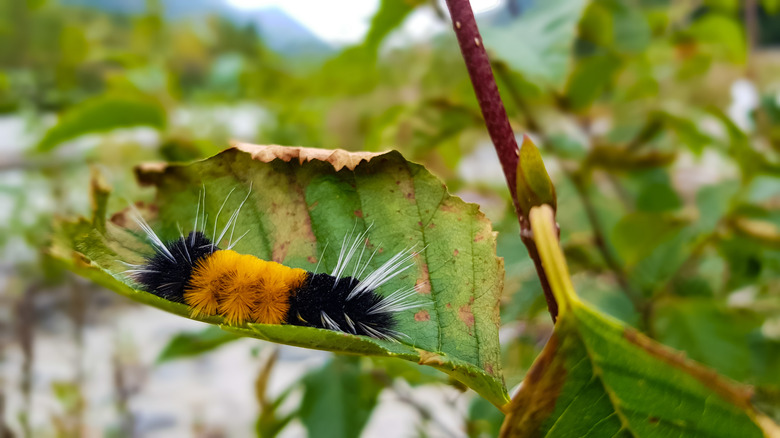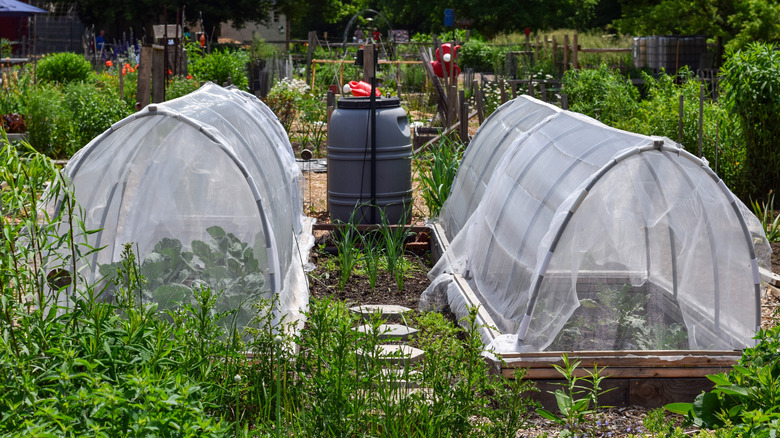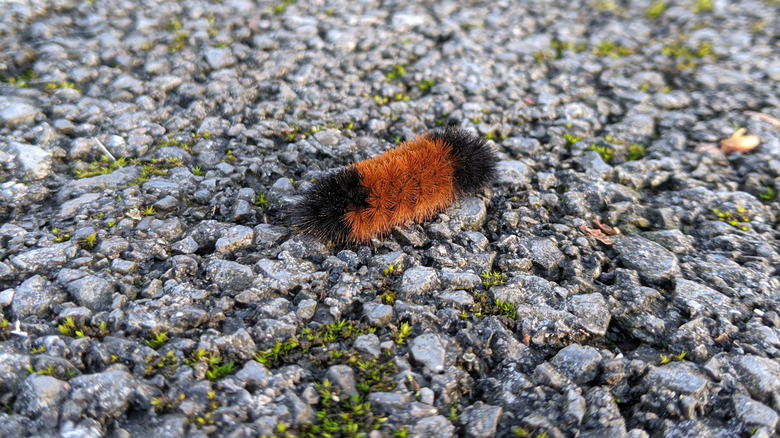The Beneficial Reason Why You'll Want Woolly Bear Caterpillars In Your Garden
Nature is amazingly symbiotic. There are plants that work as natural pest control in your yard or garden and critters that help keep your weeds in check. Case in point: the woolly bear caterpillar. With a diet that focuses on plants many gardeners consider nuisances — like clover, dandelions, lamb's quarters, and nettles — these fuzzy foragers help manage unwanted growth while feeding themselves. They may occasionally tuck into leafy garden greens or climb shrubs and trees to sample leaves, but their fondness for weeds makes them a surprisingly helpful garden guest. As they grow and eventually pupate, their waste and decomposing bodies also contributes organic matter to the soil, enriching it and supporting overall plant health.
Woolly bear caterpillars grow into Isabella tiger moths and are found throughout North America. They're not poisonous or toxic, but their bristles, which protect them from predators, can cause contact dermatitis in humans and pets. By allowing these caterpillars to inhabit your garden, you also get a glimpse into their fascinating life cycle. Watch as they progress from insatiable larvae to cocooned pupae and finally adult moths. In small numbers, they integrate well into a backyard, boosting soil health, supporting biodiversity, and providing natural weed control. However, when their population increases, the benefits can quickly turn into drawbacks.
How to keep woolly bear caterpillar numbers under control
Woolly bear caterpillars can be helpful allies when it comes to managing weeds, but if you have too many of them in your garden, your prized plants or crops may be at risk. Monitoring their numbers and employing gentle, eco-friendly deterrents is key to maintaining balance. A handful of caterpillars is no cause for concern, but when populations grow, they can devour vegetables, plants, and even young fruit trees. There are ways to manage an overabundance of these bugs without harming the environment. If you don't have too many woolly bear caterpillars, try moving them somewhere with lots of weeds, like an empty plot or green belt. Be sure to wear gloves and long sleeves and handle them gently. Attracting natural predators of woolly bears with bird feeders or forage flowers can help keep their population in check. Spraying your plants with diluted neem oil may also deter them.
Organic insecticides and diatomaceous earth work, but they'll kill the caterpillars, which isn't ideal given how helpful they can be. A more humane approach would be to install physical barriers, like floating row covers or netting, over your plants. Finally, keeping your garden tidy by removing dead plant matter, weeding regularly, and monitoring areas where Isabella tiger moths may lay eggs can reduce the likelihood of large infestations the following season. Even with them around, you'll still need to tackle some garden work yourself, such as pulling important weeds in late summer and early fall. Woolly bears hibernate in winter so they probably won't be able to eat all your unwanted plants.
Another odd reason woolly bears might be handy to keep around
Interestingly, North American folklore says that woolly bear caterpillars are also miniature weather forecasters. The width of the caterpillar's reddish-brown middle band supposedly predicts the severity of the coming winter. A wider band suggests a milder season, while more extensive black tips are said to indicate harsher conditions. Some versions of the tall tale even suggest that the direction a caterpillar crawls hints at seasonal severity, with northward crawlers signaling a mild winter and southward travelers warning of coming cold. Scientists have since shown, however, that these predictions are more myth than reality. The caterpillar's coloring is influenced by age, feeding, and species rather than upcoming weather.
Over the years, woolly bears have inspired other local traditions and even festivals. For example, the Woollybear Festival has been taking place in Cleveland, Ohio, every year since 1972. That's just one of many celebrating this famous furry caterpillar. Ultimately, these native insects serve as a reminder of seasonal changes, local traditions, and the small wonders of nature. Perhaps that is reason enough for gardeners to appreciate them, their vivacious appetite for weeds aside. And should your fuzzy friends ever up and leave, you can always keep problematic weeds out of your garden with a fast-growing cover crop like sorghum-sudangrass.


